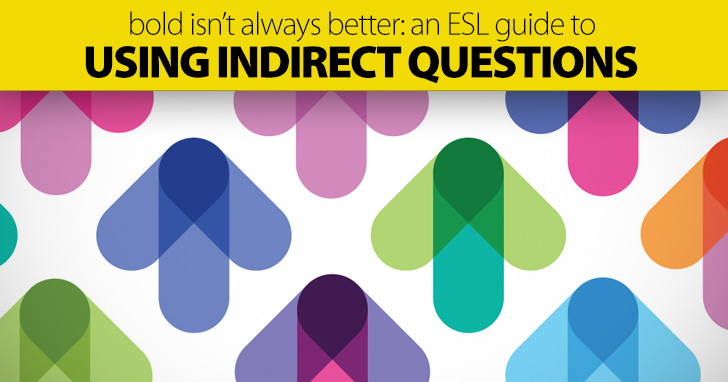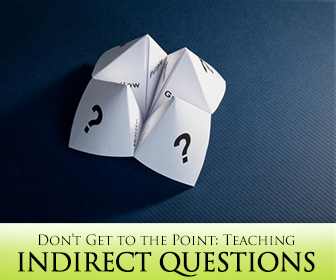Bold Isnít Always Better: an ESL Guide to Using Indirect Questions


Even beginning level students are familiar with how to ask yes/no and informational question in English. Direct questions, those that stand on their own, should be nothing new to the ESL teacher and student, but not all question in English are direct. Indirect questions, or embedded questions, are more complicated ways of asking for the same information, and once your students are at the advanced level they should be able to recognize and use indirect questions. Here is what you and your students need to know about these complex question structures.

English has two different types of indirect questions. The first type occur in reported speech – when someone is relaying something that was said at an earlier time. The second type of indirect questions are embedded questions. These questions appear in dependent clauses within a larger statement or question. Though the two types of indirect questions are similar, they are not exactly the same.

Reported speech occurs when a person tells what someone else said without using a direct quotation. In the example below, the first statement is a direct quotation. The second is reported speech.
Questions can also be changed from a direct quotations to reported speech. When they are, they are considered reported questions.

Often in reported questions, the pronouns need to be changed. Note in the previous example “you’ is changed to “me” because Mark’s conversation partner is reporting his question. This rule is not universal, however. See the following example.
In this case, “you” must be changed to “she” because Sally is not the person reporting the question. To correctly change pronouns in reported questions, your students will have to determine who is reporting the question and who the question is about.
Similar to change in pronouns, reported questions may need changes in context expressions. These expressions communicate when and where an activity takes place. Note the context expressions in the following question.
When reporting the question, the time and location at the moment are important. For example, if the reporting happens in the same context as the original question, the reported question is as follows.
However, if the reporting happens at a different location and a different time, the reported question may read as follows.
To make these changes correctly, students must determine the context of the original question as well as the context of the reported question.
Tenses often change in reported questions, and this change is called backshifting. Backshifting depends on the tense of the quoted question as well as when the reported question takes place. For a brief explanation of how to backshift in reported questions, see this summary on My English Pages.
In direct questions, subject and verb are inverted. For reported questions, the subject and verb are not inverted.
The question words (who, what, where, when, why, how) stay the same in reported questions, but yes/no questions are changed to an if clause.
While direct questions use a question mark at the end of the sentence, reported questions end with a period.
To practice reported question with your class, try this simple exercise. Arrange your class in a circle, and have one person ask a question of the second person on his left. That person acts as though she didn’t hear the question clearly and responds with, “What?” The person between them then repeats the question as a reported question. For example, one round might look like the following.
Continue around the circle until everyone has played each part in the dialogue.

Embedded questions, though similar to reported questions are not the same. Embedded questions are questions in dependent clauses associated with a main clause statement or question. The following are embedded questions.

To practice embedded questions, try this simple exercise in which students ask some of life’s big questions. Have students take turns sharing what they wonder with the class. Each student should start with a general statement. She should then ask her question to a specific member of the class. Student examples might look like the following.
Beginners may not be ready for this complicated structure, but intermediate and advanced students should be able to use them in their everyday speech.
What are your favorite activities for practicing indirect questions?